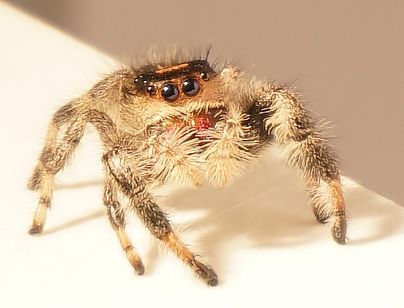Jump, Kim! Jump!
Scientists in England trained a tiny spider to jump on command, but they didn't do it just for the bragging rights.
The University of Manchester researchers trained the spider, a cute little arachnid they named Kim, because they wanted a better understanding of how spiders jump — so they can create spiderlike robots that one day might be used to kill crop-eating insects.
"There are lots of different spiders, and they are doing a good job in nature," said Mostafa Nabawy, a roboticist at the university and the lead author of a paper about the research published May 8 in the journal Scientific Reports. "If we have armies of spider-inspired robots, instead of using harmful pesticides we can use them to hunt the pests."
That dream might be an arachnophobe's nightmare. But whether it comes true, it's clear that Kim — a regal jumping spider about the size of a thumbnail — is a good jumper. High-speed video shows her leaping six times her body length from a standing position. That's like a human jumping more than 30 feet from a standstill.
The scientists recorded 15 jumps and then studied the videos and 3D CT scans to analyze the trajectory of each leap and the forces Kim applied in the effort.
It was challenging work, but simply getting Kim to jump on command was quite a feat.
Food treats couldn't be used to entice Kim because of her infrequent feeding. She would eat a cricket only once a week, Nabaway told National Geographic. "And if we just gave her prey, then she would only jump motivated by the food," he added. "Then we would have to wait a week between jumps."
So the scientists simply placed Kim on one platform and then quickly moved her to another one positioned nearby — back and forth, several times, until Kim learned she should jump to one platform as soon as she was placed on the other.
Four spiders auditioned for the study, Nabaway said, but only Kim learned to jump on cue.
In addition to showing how far she could jump, the videos and scans revealed that Kim used different strategies depending upon the distance to be covered. Over short distances, Kim used a shallow trajectory — faster and more precise but also requiring more energy. When the platforms were placed far apart, Kim jumped in a high arc — landing with less precision but expending less energy in the effort.
Using this information, the researchers built a simple prototype of a jumping robot that was able to mimic Kim's jumping motion. Next they want to gain a better understanding of how a spider's legs deliver so much energy so quickly.
"Understanding the biomechanical nature is the first step to creating jumping spider robots," Nabawy said. "Building the technology is the second."












